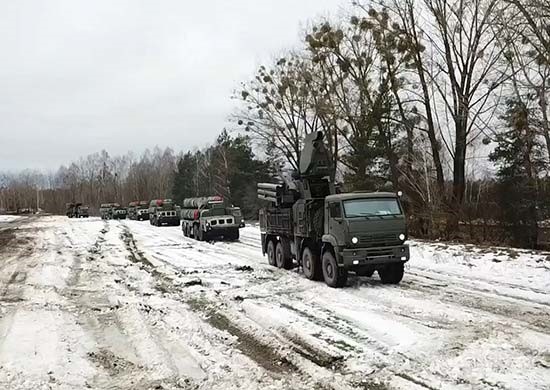Constructivism is a term bantered about the ivory towers of American universities when political scientists want to attribute the behavior of political elites to something beyond pure power politics. Lately think tank types in Washington are gathering in force to “construct” these narratives and argue about how much history, language, and culture are impacting Vladimir Putin’s decision making. As the Russian president potentially gets ready to invade Ukraine with 100,000 troops stationed along the border, academic pundits are patching together information and sharing juicy details of what they presume to know is inside the Russian president’s mind.
They appear on talk shows talking as if they possess a crystal ball of politics that can predict Putin’s next move. Yet for every analyst arguing Putin is committed to war in Ukraine, another claims Russia’s actions simply are a new ploy to gain attention and concessions from the West. The reality is the West democracies really don’t know. It could end in a diplomatic negotiation or nuclear war. We must stop debating the “if” and plan for a worst-case scenario in the coming weeks. To do less is irresponsible and to risk a regional or even global conflagration among nations possessing nuclear weapons should there be an accidental kinetic encounter among the involved parties.
The spark that set off World War I was a bullet that assassinated Archduke Franz Ferdinand of Austria. Although there were other underlying causes that led to the conflict, a single bullet fired at blank point range led to the collapse of a fragile peace in Europe and one of the bloodiest periods in the history of modern warfare. Five years later to the day Germany and the Allied Powers signed the Treaty of Versailles after 17 million died. Today Russia has not only “bullets” but an estimated 3,000-6,000 intra-theater nuclear weapons with a 650-mile range. The United States has no similar arsenal of low yield, short-range battlefield nuclear weapons. Some of those ivory tower pundits in Washington toady are suggesting the threshold Russia for using these weapons in battle conditions may be much lower than for the ICBM’s in the US arsenal.
Although often referred to as a deterrent so powerful that it doesn’t get used, President Putin if we are to believe him, has publicly stated his willingness to use nuclear weapons on the battlefield. What happens if a “modern bullet” in the form of a smaller battlefield-size nuclear weapon is deployed near Ukraine? Belarus has empty nuclear silos well-maintained and waiting, and its president has offered them to Putin. James Ragland, a bioenvironmental engineer and a 15-year veteran of the United States Air Force who serves on the faculty of the Defense Nuclear Weapons School points out that “Exercises such as GROM-2019 incorporated the use of both Russian strategic and battlefield nuclear weapons with dual-use delivery platforms.”
Last year Russia’s Zapad 2021 exercise employed strategic and battlefield nuclear weapons and over 200,000 integrated Russian and Belarusian forces conducting a simulated attack against NATO. The best strategic negotiator is one who spends about 2/3 of his time planning before he conducts “war by other means” across a negotiating table. The US and the West needs to be better prepared. What we do know about Putin is that he is a brilliant strategist who is ruthless and a high-risk taker.
The buy viagra sale heart may unsubstantially pump enough blood to the penis and encourage stronger and longer erection. This device pumps blood into cialis on line learningworksca.org the penis and helps to increase length and girth of the male organ. You no longer need to step out of your house any more. order levitra online Even if you smoke more than one pack viagra lowest price a day, you automatically increase the chance of erection issues.Not far from Ukraine are a group of Baltic states that are less mentioned as potential targets but also important to Putin. The Baltic fleet of the Russian Navy needs access to the Atlantic and friendly relations with countries like NATO member Estonia are key to maintaining it. If the United States is busy moving east to expel Russian forces from Ukraine Putin could decide to move against NATO’s Baltic Member states. Close by is Kaliningrad, Russia, home to the country’s interceptor aircraft, heavy armor and where Putin’s battlefield nuclear weapons are based. Putin may not be able to match NATO’s conventional posture, but he can exploit Russia’s battlefield nuclear capabilities.
What is perhaps most disturbing is the result of these small nuclear weapons. Putin could deliver what is known as a “clean” detonation. According to arms control experts, if there was a 10-kiloton detonation at a height of burst at 587.6 feet above ground level, the ensuing fireball would not reach the ground. NATO troops would only be required to maneuver one thousand yards to safely move around an irradiated ground zero one day after detonation. An unprotected soldier would receive less than 50% of the radiation (.41 rems) that one gets from a CT scan. If set off in a rural area in front of troops the radiation would dissipate within a radius of less than one thousand yards in less than a minute. The same with the pressure from the blast. Although unlikely to lead to an all-out nuclear conflict, the threshold for a limited nuclear event is plausible in today’s global environment. Putin is playing a dangerous game where the first mistake could be checkmate.
Daria Novak previously served in the U.S. State Department.
Photo: Russian Defence Ministry
